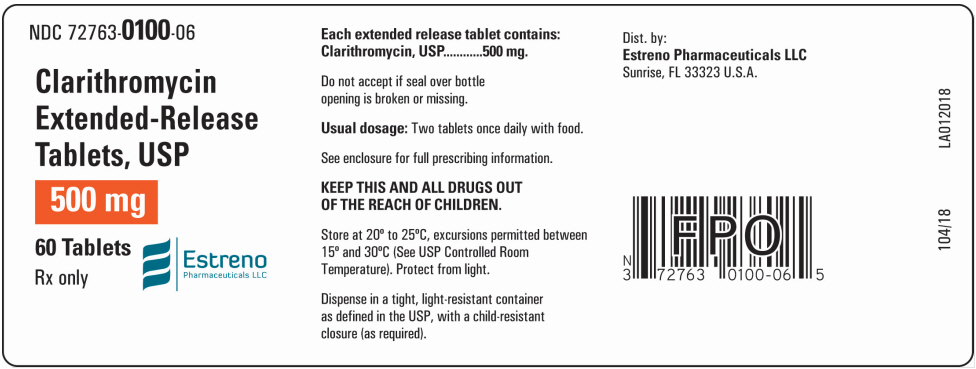For most of the drugs advantages of taking medications overweighs the potential risks however some drugs could be really dangerous for breastfed baby hence every medication shall be considered separately. In this page we will discuss about purpose of Clarithromycin Extended-release | Clarithromycin Tablet, Extended Release and its risk associated with lactation. We will also discuss the usage of Clarithromycin Extended-release | Clarithromycin Tablet, Extended Release and some common side effects associated with Clarithromycin Extended-release | Clarithromycin Tablet, Extended Release.
What is Clarithromycin Extended-release | Clarithromycin Tablet, Extended Release ?
Clarithromycin is a macrolide antimicrobial indicated for mild to moderate infections caused by designated, susceptible bacteria in the following: Acute Bacterial Exacerbation of Chronic Bronchitis in Adults (1.1) Acute Maxillary Sinusitis (1.2) Community-Acquired Pneumonia (1.3) Pharyngitis/Tonsillitis (1.4) Uncomplicated Skin and Skin Structure Infections (1.5) Acute Otitis Media in Pediatric Patients (1.6) Treatment and Prophylaxis of Disseminated Mycobacterial Infections (1.7) Helicobacter pylori Infection and Duodenal Ulcer Disease in Adults (1.8) Limitations of Use Clarithromycin extended-release tablets are indicated only for acute bacterial exacerbation of chronic bronchitis, acute maxillary sinusitis, and community-acquired pneumonia in adults. (1.9) To reduce the development of drug-resistant bacteria and maintain the effectiveness of clarithromycin and other antibacterial drugs, clarithromycin should be used only to treat or prevent infections that are proven or strongly suspected to be caused by bacteria. (1.9) 1.1 Acute Bacterial Exacerbation of Chronic Bronchitis Clarithromycin tablets, clarithromycin for oral suspension and clarithromycin extended-release tablets are indicated in adults for the treatment of mild to moderate infections caused by susceptible isolates due to Haemophilus influenzae, Haemophilus parainfluenzae, Moraxella catarrhalis, or Streptococcus pneumoniae [see Indications and Usage (1.9)]. 1.2 Acute Maxillary Sinusitis Clarithromycin tablets, clarithromycin for oral suspension and clarithromycin extended-release tablets (in adults) are indicated for the treatment of mild to moderate infections caused by susceptible isolates due to Haemophilus influenzae, Moraxella catarrhalis, or Streptococcus pneumoniae [see Indications and Usage (1.9)]. 1.3 Community-Acquired Pneumonia Clarithromycin tablets, clarithromycin for oral suspension and clarithromycin extended-release tablets are indicated [see Indications and Usage (1.9)] for the treatment of mild to moderate infections caused by susceptible isolates due to: Haemophilus influenzae (in adults) Haemophilus parainfluenzae (clarithromycin extended-release tablets in adults) Moraxella catarrhalis (clarithromycin extended-release tablets in adults) Mycoplasma pneumoniae, Streptococcus pneumoniae, Chlamydophila pneumoniae (clarithromycin extended-release tablets [in adults]; clarithromycin tablets and clarithromycin for oral suspension [in adults and pediatric patients]) 1.4 Pharyngitis/Tonsillitis Clarithromycin tablets and clarithromycin for oral suspension are indicated for the treatment of mild to moderate infections caused by susceptible isolates due to Streptococcus pyogenes as an alternative in individuals who cannot use first line therapy. 1.5 Uncomplicated Skin and Skin Structure Infections Clarithromycin tablets and clarithromycin for oral suspension are indicated for the treatment of mild to moderate infections caused by susceptible isolates due to Staphylococcus aureus, or Streptococcus pyogenes. 1.6 Acute Otitis Media Clarithromycin tablets and clarithromycin for oral suspension are indicated in pediatric patients for the treatment of mild to moderate infections caused by susceptible isolates due to Haemophilus influenzae, Moraxella catarrhalis, or Streptococcus pneumoniae [see Clinical Studies (14.2)]. 1.7 Treatment and Prophylaxis of Disseminated Mycobacterial Infections Clarithromycin tablets and clarithromycin for oral suspension are indicated for the treatment of mild to moderate infections caused by susceptible isolates due to Mycobacterium avium or Mycobacterium intracellulare in patients with advanced HIV infection [see Clinical Studies (14.1)]. 1.8 Helicobacter pylori Infection and Duodenal Ulcer Disease Clarithromycin tablets are given in combination with other drugs in adults as described below to eradicate H. pylori. The eradication of H. pylori has been demonstrated to reduce the risk of duodenal ulcer recurrence [see Clinical Studies (14.3)]. Clarithromycin tablets in combination with amoxicillin and PREVACID (lansoprazole) or PRILOSEC (omeprazole) delayed-release capsules, as triple therapy, are indicated for the treatment of patients with H. pylori infection and duodenal ulcer disease (active or five-year history of duodenal ulcer) to eradicate H. pylori. Clarithromycin tablets in combination with PRILOSEC (omeprazole) capsules are indicated for the treatment of patients with an active duodenal ulcer associated with H. pylori infection. Regimens which contain clarithromycin tablets as the single antibacterial agent are more likely to be associated with the development of clarithromycin resistance among patients who fail therapy. Clarithromycin-containing regimens should not be used in patients with known or suspected clarithromycin resistant isolates because the efficacy of treatment is reduced in this setting. 1.9 Limitations of Use Clarithromycin extended-release tablets are indicated only for acute maxillary sinusitis, acute bacterial exacerbation of chronic bronchitis, and community-acquired pneumonia in adults. The efficacy and safety of clarithromycin extended-release tablets in treating other infections for which clarithromycin tablets and clarithromycin for oral suspension are approved have not been established. There is resistance to macrolides in certain bacterial infections caused by Streptococcus pneumoniae and Staphylococcus aureus. Susceptibility testing should be performed when clinically indicated. 1.10 Usage To reduce the development of drug-resistant bacteria and maintain the effectiveness of clarithromycin and other antibacterial drugs, clarithromycin should be used only to treat or prevent infections that are proven or strongly suspected to be caused by susceptible bacteria. When culture and susceptibility information are available, they should be considered in selecting or modifying antibacterial therapy. In the absence of such data, local epidemiology and susceptibility patterns may contribute to the empiric selection of therapy.
Is using Clarithromycin Extended-release | Clarithromycin Tablet, Extended Release safe or dangerous while breastfeeding?
Clarithromycin is the only one ingredient used in manufacturing of Clarithromycin Extended-release | Clarithromycin Tablet, Extended Release, Which makes it easier to analyze its effect in breastfeeding. As per our analysis of Clarithromycin it is safe to use Clarithromycin Extended-release | Clarithromycin Tablet, Extended Release while lactating. We suggest you to check further details below about Clarithromycin usage in breastfeeding.
Statement of Manufacturer/Labeler about breastfeeding usage
8.3 Nursing Mothers Caution should be exercised when clarithromycin is administered to nursing women. The development and health benefits of human milk feeding should be considered along with the mother's clinical need for clarithromycin and any potential adverse effects on the human milk fed child from the drug or from the underlying maternal condition. Clarithromycin and its active metabolite 14-hydroxy clarithromycin are excreted in human milk. Serum and milk samples were obtained after 3 days of treatment, at steady-state, from one published study of 12 lactating women who were taking clarithromycin 250 mg orally twice daily. Based on the limited data from this study, and assuming milk consumption of 150 mL/kg/day, an exclusively human milk fed infant would receive an estimated average of 136 mcg/kg/day of clarithromycin and its active metabolite, with this maternal dosage regimen. This is less than 2% of the maternal weight-adjusted dose (7.8 mg/kg/day, based on the average maternal weight of 64 kg), and less than 1% of the pediatric dose (15 mg/kg/day) for children greater than 6 months of age. A prospective observational study of 55 breastfed infants of mothers taking a macrolide antibacterial (6 were exposed to clarithromycin) were compared to 36 breastfed infants of mothers taking amoxicillin. Adverse reactions were comparable in both groups. Adverse reactions occurred in 12.7% of infants exposed to macrolides and included rash, diarrhea, loss of appetite, and somnolence.
Clarithromycin Extended-release | Clarithromycin Tablet, Extended Release Breastfeeding Analsys
SafeCAS Number: 81103-11-9
It is not excreted in significant amount into breast milk . Commonly used for pediatric treatment which is very well tolerated. Erythromycin is a macrolide that has been related to hypertrophic pyloric stenosis with early exposition. Avoiding use in the first post-partum month would be advisable yet it may occurred while breastfeeding. Be aware of the possibility of false negative results of bacterial cultures when the mother is on antibiotics. Also, diarrheal disease due to imbalance of intestinal flora is possible.
Clarithromycin Extended-release | Clarithromycin Tablet, Extended Release Breastfeeding Analsys - 2
CAS Number: 81103-11-9
Because of the low levels of clarithromycin in breastmilk and administration directly to infants, it is acceptable in nursing mothers. The small amounts in milk are unlikely to cause adverse effects in the infant. Monitor the infant for possible effects on the gastrointestinal flora, such as diarrhea, candidiasis (thrush, diaper rash). Unconfirmed epidemiologic evidence indicates that the risk of hypertrophic pyloric stenosis in infants might be increased by maternal use of macrolide antibiotics during breastfeeding.

What should I do if I am breastfeeding mother and I am already exposed to Clarithromycin Extended-release | Clarithromycin Tablet, Extended Release?
As usage of Clarithromycin Extended-release | Clarithromycin Tablet, Extended Release is mostly safe while breastfeeding hence there should not be any concern. In case of any change in behavior or health of your baby you should inform your health care provider about usage of Clarithromycin Extended-release | Clarithromycin Tablet, Extended Release else no further action is required.
My doctor has prescribed me Clarithromycin Extended-release | Clarithromycin Tablet, Extended Release, what should I do?
Definitely, Clarithromycin Extended-release | Clarithromycin Tablet, Extended Release is safe in lactation for baby. No wonder your doctor has recommended it.
If I am using Clarithromycin Extended-release | Clarithromycin Tablet, Extended Release, will my baby need extra monitoring?
No extra baby monitoring required while mother is using Clarithromycin Extended-release | Clarithromycin Tablet, Extended Release
Who can I talk to if I have questions about usage of Clarithromycin Extended-release | Clarithromycin Tablet, Extended Release in breastfeeding?
US
National Womens Health and Breastfeeding Helpline: 800-994-9662 (TDD 888-220-5446) 9 a.m. and 6 p.m. ET, Monday through Friday
UK
National Breastfeeding Helpline: 0300-100-0212 9.30am to 9.30pm, daily
Association of Breastfeeding Mothers: 0300-330-5453
La Leche League: 0345-120-2918
The Breastfeeding Network supporter line in Bengali and Sylheti: 0300-456-2421
National Childbirth Trust (NCT): 0300-330-0700
Australia
National Breastfeeding Helpline: 1800-686-268 24 hours a day, 7 days a week
Canada
Telehealth Ontario for breastfeeding: 1-866-797-0000 24 hours a day, 7 days a week
Drug Brands with same Active ingredients



